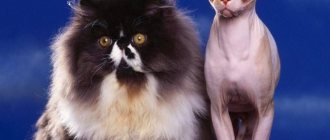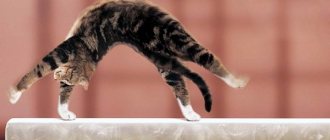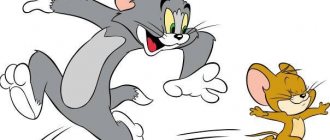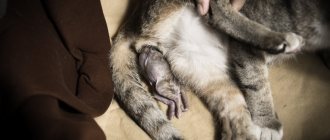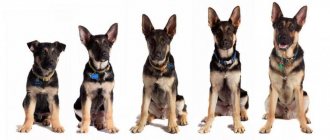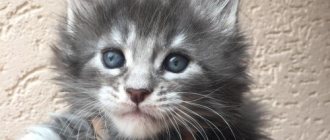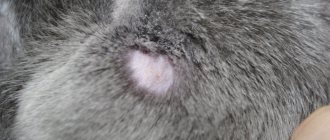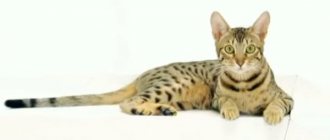Savannah
- The price for a kitten starts from 1000 US dollars.
- Weight : up to 15 kg.
- Height at withers : up to 60 cm.
- The standard was officially approved in 2001.
The breed was developed in America about thirty years ago by crossing an African serval with indigenous animals . They say that initially one serval lover simply “borrowed” such a cat for mating with her pets. The cat turned out to be prolific and easily found a common language with all the meowing inhabitants of the farm where he was staying, including the owner’s Siamese domestic cat.
It is believed that it was from this couple (a Serval cat and a Siamese cat) that the first kitten was born, which gave the name to the future breed (the kitten was a girl and received the nickname Savannah).
An Angora cat “participated” in the second generation, and the kittens already born from this litter became the basis for further selection work, and, interestingly, the owner of Savannah was not even warned about this. Important! A peculiarity of the breed is that after the fourth generation they become infertile. A kitten is valued the more highly, the closer its ancestors are to a real serval. Representatives of subsequent ones (after the first generation) are bred with Bengals, Egyptian Mau and other breeds similar in standard, but the more generations pass, the more Savannahs look like ordinary cats and, accordingly, the less they are valued.
Thus, the most expensive kitten is a hybrid of a serval and a domestic cat (savannah in the first generation). The price of such an animal in different countries of the world can range from four to twenty thousand US dollars. Kittens obtained from Savannah parents in the first generation are slightly cheaper, the cheapest are kittens of the fourth generation, which cannot be used in further breeding.
A serval is actually a wild cat. Very beautiful, but not quite suitable for keeping a home. It was precisely to combine the beauty and grace of a wild animal with the complaisance of a domestic cat that enthusiasts of breeding a hybrid wanted.
Important! According to 2015 data, the Savannah is recognized as the most expensive cat breed in the world.
Representatives of the breed in the first generation are very similar to the cheetah. These are large graceful animals with a small triangular head and large, high ears. An indicator of “pure blood” is the characteristic cheetah spots on the outside of the ears.
The body is strong, playing with every muscle, no fat folds or other traces of a well-fed home life! The limbs are long, the forelimbs are slightly shorter than the hind limbs. The tail is of medium length (in the lowered position it does not reach the ground). The coat is short, quite hard and dense (nights in Africa can be very cold), uniform over the entire body.
Another hallmark of the savannah is the characteristic cheetah spots of black or brown.
The main color can be different - blue, chocolate, brown, golden, cinnamon (sorrel), which is easily explained by the peculiarity of the origin of the breed: each time, to breed the Savannah Serval, they are bred with different breeds of cats, the color of which leaves an imprint on the first generation of the hybrid. But the spots must have only the two colors mentioned above and the “cheetah” shape (the brindle option is a disqualification).
In general, we can say that the idea of “domesticating” the cheetah into the breed was a success. Savannah is an animal that easily gets used to humans and even demonstrates a willingness to follow certain commands. Such a beast can be owned by people who need a friend and companion. At the same time, unlike Abyssinians, who are also called shepherd dogs in the cat world, savannahs, with all their activity, are quite self-sufficient to feel good alone.
We recommend reading about the top ten small, medium, large and fighting dogs.
Record holders among Maine Coons
Among the currently registered record holders, the largest domestic cats are representatives of the American elite breed Maine Coon . Such a pet is not one of the publicly available breeds, since its acquisition and maintenance are quite expensive.
Charming Maine Coons were bred by experienced breeders just over two centuries ago, and the natural conditions in the region where the work was carried out made it possible to obtain an animal with thick and very long hair. As a result, cats and cats of this breed are not only excellently adapted to harsh weather and can easily withstand frost, but also have an original appearance and impressive, large size.
This is interesting! In the course of strengthening and improving the main breed characteristics of the Maine raccoon cat, it was possible to breed a large animal with an original exterior.
The most famous record holder of the Maine Coon breed is the longest and largest cat in the world named Sweetie, originally from Nevada. The body length of this cat from the tip of the nose to the tail is 1 meter 23 cm 2 mm. The record was officially registered, and the owner of the champion characterizes her pet as a very kind and affectionate cat.
Before the cat Stewie, the record holder was also a representative of the Maine Coon breed, whose weight at the age of five exceeded fifteen kilograms, and the length of his tail was 41.5 cm. No less famous was the Finnish Coon named Missy, who had whiskers or whiskers 19.0 long cm.
The record holder was also the mixed-breed cat Velvet, whose age three years ago was a quarter of a century. However, as practice shows, the average life expectancy of representatives of this breed rarely exceeds twelve years.
Return to content
Caracal
- Price : on average 8,000 US dollars (fluctuations are possible depending on the country and purity of blood).
- Weight : up to 22 kg.
- Height at the withers : up to 50 cm. Some animals reach 1 m in length.
The caracal is a cat very similar to the lynx , mainly due to the characteristic tufts on the top of the ears. It is also called the steppe or desert lynx, but the true lynx is slightly larger.
This animal lives in different parts of the world - in Africa, the Middle East, Asia Minor and Central Asia, and the Arabian Peninsula.
Did you know? It turns out that our ancestors hunted not only with the help of dogs and birds. Wild cats were also involved in this aristocratic occupation. For example, back in the 5th century AD, two specially trained cheetahs were delivered to the Byzantine emperor from India. Less rich and noble hunters tamed less expensive representatives of the cat breed, including caracals, for the same purposes.
The name of the breed comes from the Turkish karakulak, which literally means “black ears.”
The caracal is a large cat with a uniform color of all shades of yellow-brown, ranging from the color of light sand to milk chocolate. The coat, like that of the Savannah, is short and thick. The body is strong, movements are full of inner strength and grace.
If the caracal is not the most expensive cat breed in the world, then it is certainly one of the most beautiful and exotic.
Important! The caracal is at least three times larger than an ordinary domestic cat, so not every family can afford to have such a predator in their apartment.
Despite the complete external similarity with a wild cat, the caracal (if, of course, you purchased a kitten in a specialized nursery) is quite domesticated and can be among people as a pet. They get along well with children, enthusiastically play according to the rules proposed to them (for example, they can be taught to find and bring an abandoned or hidden object to the owner) and adore attention and affection.
How to recognize a cat's breed by its special coat
You can understand what breed a domestic kitten or an adult cat belongs to by the length and structure of the coat. The coat of different cats can vary greatly.
Very long
Based on the long coat a kitten has, one can determine whether it belongs to a fairly large number of breeds.
The following cats have long, thick hair with a densely packed undercoat:
- Persians;
- Siberians;
- Turkish Vans;
- Angoras;
- Somalia;
- Norwegian Foresters - owners of feathers on their legs and a luxurious collar on their necks;
- Neva Masquerade;
- British Longhair;
- Himalayan;
- Maine Coons;
- Burmese;
- ragdoll, etc.
Long-haired breed - Persian cat
Longhaired British cat
Neva Masquerade - long-haired cat
Long curly
Cats of the following breeds have cute, wavy, long curls that you definitely want to touch:
- Bohemian Rex;
- laperm;
- Selkirk Rex.
Short curly
Unusual short tight curls adorn cats of the following breeds:
- Cornish Rex;
- German Rex;
- American Wirehair;
- Devon Rex.
The Cornish Rex is a breed with short, curly hair.
Hairless
Nowadays you won’t surprise anyone with bald, scary cats. Their cohort is constantly growing thanks to the efforts of felinologists and professional breeders.
Contrary to popular belief, these cats are not always completely naked. Most often they have a residual coat, according to which they are divided into breed subgroups.
It is extremely rare for a small kitten to be born completely hairless; usually the hair falls out completely later. It is almost impossible to immediately determine what it will become in the future.
Hairless cats include:
- all sphinxes: Canadian, Don, St. Petersburg (Peterbald);
- Dwelf;
- Minskina;
- elf;
- kohanu;
- bambino;
- Ukrainian Levkoy.
Hairless cats - sphinxes
Chausie
- Price : on average from 8,000 to 10,000 US dollars, in some cases it can rise to 20 thousand.
- Weight : from 12 to 15 kg.
- Height at withers : within 40 cm.
- Country of origin of the breed : United States of America.
Chausie is one of the rarest breeds of cats , and there is reason to believe that breeders deliberately seriously limit the rights to breed these animals in order to keep prices for kittens at a high level.
This cat was bred by crossing an Abyssinian domestic cat and its wild Egyptian counterpart.
Chausie has three color options - wild, blue and sorrel. The ticking characteristic of the Abyssinian cat is also a distinctive feature of this breed.
Important! Ticking is a type of coat color where each hair has areas of different colors in a certain sequence. A ticked animal looks as if its fur shimmers in a whole range of shades (the impression is enhanced if you carefully stroke the fur against the direction of its growth).
Chausie breeding began in the second half of the last century. These animals differ from the Abyssinians primarily in size (the Chausie is at least twice as large), but in other respects there are a lot of similarities. In addition to their ticked coat, the Chausie, like their more common relatives, has an elongated, muscular and lean body with a small head and high-set ears (sometimes they are decorated with lynx tassels, which is not surprising, since the swamp lynx is among the wild ancestors of the Chausie). Chausies are extroverts by nature. They love attention and affection, as well as communication with their beloved owner. And if you add to this the complete external resemblance to a wild cat, the impression is simply unforgettable!
Modern technology will not let your pet get bored: check out ten funny videos for cats.
Khao-mani
- Price : 7000–10000 US dollars.
- Weight : 3–4 kg (males).
- Height at withers : 25–30 cm.
- Other names : cat with a golden and silver eye, brilliant (diamond eye), and also precious white.
Kao-mani, unlike the three previous breeds, is a completely miniature domestic cat. Its distinctive feature is its snow-white fur and charming “different eyes” (one eye is always blue, the other can be yellow, gray, sometimes green).
The birthplace of Khao Mani is Thailand (until 1939, the state, as you know, was called Siam).
Did you know? Unlike their more famous compatriots - Siamese (or Thai) cats, the Kao-Mani was preserved for a long time as a true treasure of the state, a “royal breed”, which could not be owned by anyone except members of the monarch’s family, much less taken out of the country.
Only a year before the end of the second millennium, kao-mani came to the United States and, thanks to its aristocratic appearance, and moreover, its ancient history and “royal origin,” it immediately gained enormous popularity. The fact is that a century earlier, the cunning Thai king Chulalongkorn V “slipped” a Siamese cat to the Europeans as a kind of bribe under the guise of that very famous royal breed.
It is not surprising that when the “deception” was finally revealed, the real ancient Thai Khao Mani cat, having barely left its homeland, instantly took pride of place in the ranking of the most expensive breeds.
Important! Divergence of eyes is not a mandatory sign of a Kao-Mani; according to the standard, cats are blue-eyed. But the market value, thanks to the popular legends about the ability of such cats to bring happiness and well-being to the home, is higher for animals with heterochromia.
The coat is short, smooth, and fits well to the body. The character is lively and active. Like the Siamese cats we are used to, Kao Mani cannot tolerate loneliness and idleness; this breed is not suitable for people who spend all day at work. But the animal will gladly give all its warmth and tenderness to an attentive and caring owner.
How to properly care for a purebred cat?
Any pet, whether outbred or noble blood, needs decent care. The following procedures will be relevant for all breeds:
Nail trimming and combing
We trim the claws. Nails should be trimmed using a veterinary nail clipper. The most important thing is not to damage the living part of the nail. The vessels on the transparent claw are easily visible. You need to step back 2-3 mm from them and cut off the tip.
Tips for trimming cat's claws
The animal will struggle, so the procedure must be carried out with an assistant. We comb the pet. Cats with luxurious long hair need to be brushed twice a day, and pets with medium-length hair need to be brushed every 3-4 days. The voluminous coat is combed out with a slicker brush and combed with a simple comb.
Hygiene
The list of regular hygiene procedures for cats includes:
- Teeth cleaning. Your pet's teeth should be brushed at least once a week using a cat brush/finger brush and veterinary toothpaste. It is better to instill in your kitten a love for this process from an early age;
- Water procedures. It is not necessary to wash cats often, as water causes them great stress. Bathing is recommended only if the cat is very dirty or before a show. Use special shampoo from a pet store. You can read more about how to wash a cat on our portal.
- Eye wash. If discharge appears near your pet's eyes, you need to rinse the eyes with warm water and a cotton swab. If the discharge is cloudy, you need to show the cat to a veterinarian;
- Ear cleaning. The ears should be regularly inspected and wiped with a special solution if dirt appears. Otherwise, serious illnesses may develop.
Wool
Pedigree cats have a wide variety of coats. Long-haired, short-haired, hairless - this is not the entire list of nuances that should be taken into account when caring for the coat of your “aristocrat”. Different breeds have different hair structures, so each of them requires an individual approach. Basic tips for caring for your pet's fur are presented below.
Hair care for purebred cats
Safari
- Price : 4000–8000 US dollars.
- Weight : up to 15 kg (cat), 8 kg (cat).
- Height at withers : up to 60 cm.
- Country of origin : United States of America.
- Another name : leopard cat.
An amazing thing: with the huge price of kittens, this breed is not officially recognized by many felinological organizations (the exception is the International Cat Association TICA, which included the breed in its registries; many other organizations consider such animals to be Bengals).
As in the case of the savannah and chausie, we are talking about a hybrid of a wild cat with a domestic one, but the “wild” blood in this case is a little-known South American representative of the cat breed - the Geoffroy (this animal is similar to a leopard, but much smaller than its relative ), as “domestic” - Bengals, Siamese or European or American shorthair cats.
Did you know? It is interesting that the first experiments on this crossing were aimed not at breeding a domestic cat with the appearance of a leopard, but at achieving a more prosaic and at the same time more serious goal - studying methods of combating leukemia, because hybrids, as it turned out, are not susceptible to such a dangerous disease .
The crossing was very difficult: since wild and domestic cats have an unequal number of pairs of chromosomes, as a result of matings, infertile males were often born. The resulting hybrid was given different names, but the name associated with African hunting stuck. Externally, the cat is very similar to a leopard, its body is covered with spots of the same shape, the main color (depending on the cat to which Geoffroy was bred) is golden, brown or red, very rarely smoky.
The closer the representatives of the breed are to the wild progenitor, the higher the cost of the kitten.
We recommend reading about cat food: Kitekat, Purina, Royal Canin, Hills.
Cat structure and biological features
Representatives of the cat family are distinguished by extraordinary elegance and grace, mobility and energy, which largely determines the structure of the animal.
Cat skeleton
It is advisable to start describing the structural features of a cat with the skeleton, the structure of which is in many ways reminiscent of the structure of the skeleton of all mammals, differing in the shape and arrangement of some bones, which is explained by the horizontal position of the cat’s spine and the fact that the functioning of the organ systems of this animal is adapted to its lifestyle.
Anatomical structure of the cat skeleton: 1 – facial part of the skull; 2 – lower jaw; 3 – brain part of the skull; 4 – first cervical vertebra; 5 – cervical vertebrae; 6 – shoulder blade; 7 – thoracic vertebrae; 8 – ribs; 9 – lumbar vertebrae; 10 – sacrum; 11 – pelvis; 12 – caudal vertebrae; 13 – femur; 14 – tibia and fibula; 15 – metatarsus; 16 – fingers (paw); 17 – metacarpus; 18 – radius and ulna; 19 – humerus; 20 – sternum.
The cat's skull has a round shape. Moreover, it is significantly shorter than that of many other predatory animals. The size of the skull of an adult varies depending on gender, breed, and individual hereditary characteristics. The bones of the skull are much larger than the bones of the facial part of the skull. This feature makes the cat's appearance different from other animals. A cat's spine is flexible and mobile. It consists of 27 vertebrae: 7 cervical, 13 thoracic and 7 lumbar. Below the lumbar region there are 3 fused vertebrae that form the sacrum. Next come the caudal vertebrae, the number of which varies among representatives of different breeds. On average, a cat's tail consists of 20–23 vertebrae. But there are also short-tailed and tailless cats, in which the number of vertebrae is much smaller, for example, Maine cats. Thanks to the elastic and movable tail, cats can maintain balance while jumping and in the event of a fall from a height. Also, experienced owners of these animals can easily determine what mood they are in by the position and movements of their pet’s tail.
External structure
The cat is rightfully considered one of the most beautiful animals. Her body is long, flexible, graceful. The special grace of movement is achieved due to the fact that the bones of this animal are particularly dense and at the same time plastic, which increase due to the free connection with the muscles through strong and mobile tendons.
The cat is one of the most beautiful and graceful animals.
Most cats have strong, medium-length limbs with well-developed muscles. Thanks to this, the cat is able to quietly and unnoticed sneak up on prey while hunting and make a swift jump. This animal moves extremely carefully and silently, since its paws have pads on which sweat glands and sensitive nerve endings are located. In addition, a cat's limbs are extremely flexible, allowing them to move quickly and quickly while hunting. Cats have 5 toes on their front paws and 4 toes on their hind paws, with sharp sickle-shaped claws.
The appearance of a cat speaks of strength and dexterity, courage and pride, dignity and intelligence. These animals have an independent character, but at the same time they need care and love.
It is well known that cats can regulate their position: if the animal is in a calm state, the claws are usually hidden in leathery bags and therefore do not become dull, and when danger arises, the cat spreads its fingers and extends its claws out. This ability is explained by the fact that they are located on the phalanges of the fingers, where there are tendons and muscles that control the extension and retraction of the claws into the leathery pouches. Nature endowed cats with this feature in order to protect the main natural means of attack and defense from being worn down when walking.
A cat's teeth are a weapon of attack and defense.
A cat's teeth are not only a formidable weapon, but also an important component of the digestive system. The animal bites off and grinds food with its teeth, with their help it participates in fights with relatives and defends itself in cases where it senses the approaching danger for itself or its kittens. An adult cat has 30 teeth, which are arranged according to the following pattern: – lower jaw: 6 front incisors, on both sides of which there is 1 canine and 3 molars (2 premolars and 1 molar); – upper jaw: 6 front incisors, on both sides of which there are 1 canine and 4 molars (3 premolars and 1 molar). Incisors are small teeth with jagged edges. With their help, the animal grabs small pieces of food and gnaws bones. The main tool of a cat when catching prey and defending against enemies are long and sharp fangs with deep roots.
Kittens are born toothless. Their milk teeth grow within 1 month of life. When the kitten reaches the age of 6 months, the baby teeth are completely replaced with permanent ones.
Cats' gums are not particularly sensitive because they have few nerve endings. Externally, they are a mucous membrane that covers the edges of the jaws on all sides and forms the sockets of the teeth and dental necks. There are many blood vessels running through the gums. The tongue plays an important role in digestion. In cats it is elongated, mobile and flat. The entire surface of its mucous membrane is completely covered with a large number of coarsened papillae, due to which it is rough to the touch. The papillae are involved in the process of lapping: these peculiar movable funnels retain water or liquid food, which facilitates its entry into the oral cavity. In addition, the lingual papillae act as a brush when the animal washes itself and cleans its fur. Also on the cat's tongue there are sensitive papillae, which are responsible for the animal's sense of touch.
The papillae on a cat's tongue help her lap.
The function of touch is also performed by an organ that is often called the mustache. The scientific name for these long, stiff hairs located on either side of the nose and above the eyes is “vibrissae.” They are also called tactile or tactile hairs. The follicles from which they grow have a large number of nerve endings. The skin between them also has increased sensitivity, which helps the animal navigate not only in the light, but also in the dark. The cat's nipples are located on the stomach and chest, in the area of the mammary glands. In females, they serve to feed the offspring. Different pairs of nipples produce different amounts of milk. For example, the groin nipples contain the largest amount of milk; in the nipples located in the upper part of the body, it decreases. Currently, there are cats with a wide variety of colors, length and thickness of coat, depending on the breed to which the animal belongs. Some breeds have short and velvety hair (British Shorthair), others have long and wavy hair (La Perm), and there are also breeds that have no hair at all (Sphynx).
Vibrissae perform the function of touch.
Regardless of the length, a cat's fur consists of 2 layers: a thin inner coat (undercoat) and a coarser outer coat (protective). The main function of the coat is thermoregulation and protection of the body from the harmful effects of the environment. In the hot season, cats get rid of their undercoat, thanks to which their coat becomes light and fluffy animals (for example, Persian cats) tolerate high air temperatures relatively calmly.
Those people who carefully observe cats can determine the animals' intentions by the movements of their whiskers: concentrating before jumping, trying to determine the source of an attractive smell and the distance to it, etc.
Thermoregulation is also provided by the pores on the cat’s skin, in which the outlets of the sweat glands, blood vessels and nerve endings are located. Along with hair, these pores prevent excessive fluid secretion and protect the body from the entry of harmful microorganisms and bacteria.
Cat fur performs a thermoregulatory function.
The skin of a cat is unusually mobile, which allows it to lead an active lifestyle typical of these animals. This also contributes to the fact that wounds received in fights with dogs or other cats, in most cases, turn out to be superficial and not life-threatening.
Vitamin D, contained in fatty grease, enters the cat's digestive tract during the washing process and promotes normal metabolism.
The skin also contains sebaceous glands, which secrete fatty lubricants necessary for the proper functioning of the animal’s body. Thanks to this, the cat's fur is protected from harmful environmental influences and is silky and beautifully shiny. Sweat glands are also located on your cat's toes and paw pads.
Internal structure
In terms of the location and functioning of the internal organs, the internal structure of a cat is in many ways similar to the structure of other mammals. But there are also differences that are unique to this species of animal. The main organ of the circulatory system is the heart - a hollow muscular organ that is located inside the chest, behind the median sternum. The weight of a cat's heart is directly proportional to the animal's body weight. In each specific case, this is approximately 0.6% of body weight. A cat's heart consists of 2 atria and 2 ventricles.
Within 1 minute, the cat makes 20–30 breathing movements. In a kitten, their number increases to 40.
Cats have 2 circles of blood circulation, like all mammals. Blood circulation is carried out through arteries leading from the heart to capillaries, which penetrate all internal tissues and organs. Metabolism occurs there, then blood, saturated with carbon dioxide and containing waste products of the body, enters the veins leading to the heart. The veins form the second, or pulmonary circulation. Venous blood enters the right ventricle of the heart, then through the pulmonary arteries into the lungs. The organs of a cat's respiratory system are designed in such a way that they can function well in various environmental conditions. The task of these organs is to ensure gas exchange and deliver oxygen to the body tissues. They also serve to some extent as excretory organs, since through them excess moisture and harmful gases are removed from the body, and they participate in heat exchange because they remove excess heat from tissues. The respiratory system of a cat consists of the nose, nasopharynx, larynx, trachea, bronchi and lungs.
Domestic cats definitely need fresh air.
The lungs are the main organ of the respiratory system. This is a paired organ consisting of 2 lobes (right and left), which occupy most of the chest, as in all warm-blooded animals. They consist of alveoli - pulmonary vesicles, tightly intertwined with a network of capillaries, which serve as conductors for gas exchange. The respiratory organs are covered by a mucous membrane, which serves as their protection. In the process of breathing, air enters the larynx through the nose, and from there into the bronchi and lungs. The normal functioning of the circulatory system is associated with this. If the body temperature or the environment is elevated, or if the cat is in an excited state, the breathing rate increases. Sometimes the animal breathes with its mouth open. The cat's digestive system consists of the mouth, pharynx, esophagus, stomach, small and large intestines. Also in the process of digesting food, the pancreas, gall bladder and duodenum perform an important function. From the oral cavity, the food chewed by the animal enters the esophagus, which is a muscular tube that can increase in diameter when it becomes necessary to push food into the stomach. The inside of the esophagus is lined with mucous membrane. Under the influence of saliva, food begins to break down and partially digest in the oral cavity. The digestion process continues in the stomach, located in the front of the peritoneum. The cat has a single-chamber stomach, lined from the inside with a mucous membrane that produces gastric juice, which is necessary for the subsequent processing of food.
The mucous membrane of the small intestine is lined with villi, which ensure the absorption of nutrients. This is where food that enters the intestines is disinfected. This function is performed by numerous lymph nodes.
From the cavity of the cat’s stomach, 2 holes open, shaped like cones. One of them connects the stomach with the esophagus, the other with the duodenum. From the stomach, food enters the small intestine, where final processing of food occurs. The small intestine is a long thin tube twisted into several loops. The length of the small intestine is often 4 times the length of the cat's body. Inside the intestines, food is affected by a pancreatic enzyme. The continuation of the small intestine is the large intestine, which receives unprocessed solid food debris. They are enveloped in mucus secreted by the walls of the large intestine. It consists of three elements: the cecum, or appendix, colon and rectum. The rectum serves to remove compressed feces from the body. The anal glands are located on the sides of the cat's anus. They secrete a secretion with a pungent odor. In addition to the excretory function, the rectum also maintains bacteriological balance in the body, because the conditions necessary for the proliferation of beneficial bacteria are maintained inside it.
The salt and water balance in the cat's body is ensured by the urinary system. During the breeding season, the animal's urine emits a particularly pungent odor, very persistent, because this is how cats mark their territory.
The organs of the urinary system are responsible for removing excess fluid from the animal’s body. The cat's urinary system consists of the kidneys, bladder and urinary tract - the ureters. In these organs, urine is formed and accumulated and is subsequently removed from the body along with harmful substances dissolved in it. Urine is formed in the kidneys, more precisely, in the renal pelvis, from which it flows through the ureters into the bladder, where there is a closing muscle that prevents spontaneous urination. The cat’s urethra has a distinctive physiological feature: stenoses are special narrowings that serve to facilitate faster passage of sediment present in the urine. The male reproductive system consists of the testicles and vas deferens, which open into the urethra. Through this channel, sperm enters the reproductive organ. The testicles, the sex glands of cats, are located in the scrotum, which is formed by a fold of skin at the base of the penis. Male reproductive cells - sperm - are formed in the testicles. The internal reproductive organs of a cat are the ovaries, fallopian tubes and uterus. The ovaries produce female reproductive cells - eggs. A cat's external genitalia are the vagina and vulva, which are located next to the anus. The endocrine glands are of great importance for the life of the animal: the hypothalamus, adrenal glands and the thyroid gland. They regulate many vital processes occurring in the cat’s body and protect it from diseases.
Physiology
Cats have a uniquely organized nervous system that is highly sensitive and a more developed sensory system than humans. The functioning of the nervous system is carried out by transmitting nerve impulses to the brain, which contain information about the state of the organs and the processes occurring in them. The role of impulse transmitters is performed by neurons, special nerve cells. No other animal's senses are as developed as those of a cat. So it is advisable to consider this feature of the cat in more detail.
Vision
If you compare a cat with other pets, you will notice that it has the largest eyes relative to its body size. Scientists have long noticed a unique feature of cats - binocular (stereoscopic) vision. This property is determined by the unusual location of the eyes: they are located in front, on either side of the nose, and the animal has the ability to view objects of interest at an angle of 205 ° in the same direction while simultaneously crossing the field of vision at a central point. This property allows the cat to accurately determine the distance to a particular object. In addition, with this arrangement of the eyes, the animal gets the opportunity to see what is located not only directly in front of it, but also on both sides.
Cats can distinguish the colors of objects, but only a limited number of shades. Another feature of cats' vision is that they see moving objects much better than those at rest.
The iris surrounding the pupil of a cat's eye has mobility, like that of all representatives of the class of mammals. It is driven by muscles connected to the eyeball. Due to this property of the iris, in bright natural or artificial light, the pupil of a cat's eye is elongated vertically and takes on an elliptical shape. This protects the animal's eye from penetrating more light than is necessary to perceive the surrounding world.
Cats have very sharp eyesight.
Thanks to the structure of their eyes, cats can see in the dark. It is a mistaken belief that cats see perfectly in the dark because their eyes can glow. The reason cat eyes glow in the dark is that they have the ability to accumulate reflected light rays. With the help of perfectly developed vision, the cat catches the reflection from objects of even the weakest ray of light penetrating into the room where it is located, and thanks to this it orients itself in space. But in absolute darkness, the animal, of course, cannot see.
A cat's pupils dilate and become completely round when a lot of light enters the eyes. If the cat's pupil remains dilated in the light, this may be a consequence of the effects of medications or a symptom of some disease.
Representatives of the cat family have another feature of the structure of the eyes - the so-called third eyelid, or nictitating membrane, the function of which is that it protects the cornea of the eye from foreign bodies, such as dust. This becomes possible because the third eyelid can stretch and cover the entire surface of the eye. Despite the fact that the third eyelid has a protective function, it is subject to inflammation and is very sensitive to infections. The cat owner should be aware of this and not neglect the rules of hygiene when caring for the eyes of their pet, since some diseases cause prolapse of the third eyelid. The color of a cat's eyes can vary from light golden to blue. This depends on the degree of content of the coloring substance - pigment - in the iris. Like other animals, there are also albinos among cats, whose fur has no pigment. Their eyes are most often red.
Smell
The sense of smell in cats is much better developed than in other representatives of the mammalian class. It helps to establish relationships between related individuals, as well as between animals and humans. This can largely be explained by the fact that felines were originally nocturnal. It was at this time of day that they went out hunting and were active. It was necessary to navigate in space in conditions of poor visibility and even in low light to find prey during the hunt.
The sense of smell appears in young kittens before hearing and vision and helps them find their mother and distinguish her from other animals by smell.
In relationships with representatives of the opposite sex, cats' sense of smell also helps, since cats use marks to determine the boundaries of their territory. Cats' sense of smell is selective: they are able to smell only those odors that have one or another meaning for them, and this is an important feature of their sense of smell. Extraneous, insignificant odors seem to be blocked, the brain does not react to them, so the animal is not distracted by them and does not lose track. The sense of smell performs a specific function when the mating season begins in cats, since a female, ready for fertilization, emits a special smell that allows the male to detect her even if she does not make characteristic sounds.
A good sense of smell helps a cat hunt.
Cats have much less developed taste organs than dogs. The papillae located on the surface of the tongue allow cats to distinguish only contrasting tastes: bitter, sour, sweet, salty. Therefore, food preferences can be explained more by a keen sense of smell than by taste. Not a single cat will remain indifferent to valerian, which has an effect on them similar to a narcotic. At the same time, as experts noted, animals of different sexes react to valerian differently.
Cats quickly get used to their environment, due to which they stop reacting very sharply to the unpleasant odors that accompany them every day. For example, a domestic cat can easily perceive household odors of air freshener, washing powder, and deodorant.
Females, as a rule, become excited by the smell of this plant, but quickly calm down and become lazy and lethargic. Cat owners use this property of valerian in cases where the animal is very excited and needs to be calmed.
Cats like valerian.
Valerian can have the exact opposite effect on males. Even one drop of valerian tincture, accidentally falling on the floor, can cause a real attack of rage in a cat: it will begin to lick the floor, roll around, rub against the place where the drop hit, howl in a hoarse guttural voice, hiss, scratch, and show aggressiveness when the owner tries to erase valerian from the floor or take away the found bottle of tincture from him.
Touch
Often a cat is the initiator of the owner picking it up, caressing and stroking it, while the animal squints, purrs and looks very happy. True, this only happens in cases where the owner strokes the cat in the direction of hair growth, and not vice versa. If you stroke a cat against the grain, it will most likely get angry and scratch you. This behavior is explained by the fact that the cat’s senses of touch are not located on the skin, but on the surface of special tactile hairs, which are highly sensitive on the head and front paws. Cats have a well-developed sense of touch. Through the corresponding organs, the cat receives most of the information about the outside world.
Cats love to bask in a warm place.
In addition to the tactile hairs located on the head and paws, this animal can touch the surrounding space with the entire surface of the body. Cats' paw pads have a special structure. Because of this, cats really don’t like to step on a dirty or wet surface, after which they always shake their paws, which is explained not only by the well-known cleanliness of these animals, but also by the extreme sensitivity of their paw pads.
A cat’s organs of touch and balance work harmoniously, thereby ensuring the smooth operation of internal systems; usually even small kittens have good health and good immunity.
Unlike dogs, who become familiar with an object of interest through their sense of smell, a characteristic feature of all representatives of the cat family is that they first touch an unfamiliar object with their paw and only then smell it.
Hearing
The external hearing organs of a cat are erect, movable ears, in the auditory canals of which there is a huge number of nerve endings.
Perceiving any sound, a cat can determine its frequency, pitch and strength with maximum accuracy.
Thanks to the unique ability of the hearing organs to distinguish sounds in the ultrasonic range, cats can communicate with their kittens. This property also helps cats successfully hunt rats, mice and other rodents. The ability of these animals to distinguish more than 100 different sounds is unique, especially considering that the human ear does not perceive even half of these sounds.
Sense of balance
A cat's sense of balance is directly related to its sense of touch. This animal is capable of maintaining balance in the most seemingly unimaginable conditions (sharp tops of a picket fence, thin tree branches, a completely smooth surface of a window cornice, etc.), so its sense of balance deserves special consideration. The sense of balance is activated by an organ located in the inner ear and closely connected with the auditory and visual systems.
A sense of balance allows cats not to be afraid of heights.
From this we can conclude: the normal functioning of a cat’s sense of balance is possible only if all other systems of the body are functioning smoothly. Often cats calmly and without fear walk along high fences, cornices, roofs, and tree branches. Animals achieve this thanks to their sense of balance, although they also sometimes fall, often from quite a great height. But here, too, the cat’s sense of balance helps out, helping it land on its paws. This does not mean that the cat is invulnerable. Falling from a great height can cause serious injury and even death, as well as shock. Cats also have a well-developed sense of time, the rhythm of day and night. Cats follow a certain regime and extremely do not like to deviate from it. If you call your pet home and feed it after arrival, then after a few days the animal will return home from the street at the same time.
Bengal
- Price : 1000–4000 US dollars.
- Height at withers : 28–32 cm.
- Weight : 4-7 kg.
This is one of the most common domestic cats in our country, resembling wild animals in appearance. The breed was developed in the USA in 1963 by crossing a domestic cat and a leopard . At the same time, unlike the giants described above, in this case it was possible to obtain an animal of quite usual size for a domestic cat, but with a completely wild temperament and a luxurious leopard color.
Bengal cats are not aggressive, but, unlike Abyssinians who need companionship, they are much more independent and tend to “walk on their own.”
It is believed that no more than 20% of the blood of these animals from their wild ancestors has been preserved, the rest has been “captured” by peaceful domestic kitties, so one should not expect displays of aggression from Bengals. Important! One of the distinctive features of Bengals is their love for various water procedures, which is unusual for domestic cats.
Outwardly, it is difficult to confuse a Bengal cat with another breed. A strong and robust body with a small wedge-shaped head and a slightly square mouth. The ears are small, slightly rounded, the eyes are slanted, the color of green tea. The coat is short and very soft. Color - gray, white or golden, leopard or marbled spots (stripes) cover the entire body.
It will be useful for cat owners to read: do cats need clothes, how to trim a pet’s claws correctly, how to make a scratching post, how to train a cat to use a litter box.
Maine Coon adult size
The world's largest breed, the Maine Coon, is surrounded by many myths and stories that also relate to the size of these animals. However, the average weight of an adult and fully developed male Maine Coon Cat ranges from 5.9-8.2 kg, and the body weight of a female ranges from 3.6-5.4 kg.
The height of an adult Maine Coon, as a rule, does not exceed 25-41 cm, with a total body length with tail of up to 100-120 cm . The maximum length of the tail of the average representative of the Maine raccoon cat breed most often does not exceed 35-36 cm. The Maine raccoon cat reaches its full size at the age of three to five years, which is quite late compared to other popular and widespread breeds.
This is interesting! Thoroughbred animals, when gaining a body weight of 8-9 kg, look much larger and more massive, which is due to the characteristic exterior, represented by an elongated and elongated body with large and well-developed muscles, strong limbs, as well as a massive neck, head and shoulders.
Return to content
Singapore
- Price : from 500 US dollars and above.
- Weight : 2–3 kg.
Despite the fact that the birthplace of this breed, as the name suggests, is Asia (Singapore), the standard was developed by the Americans. Here is how it was. A certain geophysicist from the States named Meadow, who was in Singapore on some business, was so captivated by the extraordinary charm of the local tiny cats that he took four of them home with him at once - a boy and three girls.
As usual, Asians began to be happily crossed with local breeds, resulting in a very interesting hybrid.
Did you know? When the Singaporean breed began to gain popularity in the States, Mr. Meadow even tried to claim his “copyright” on it. However, the unlucky American was unable to prove that it was he who first imported Singaporean cats to the USA, which, however, did not prevent him from entering the history of the creation of the breed, at least unofficially.
The main distinguishing feature of Singapore can be described with the romantic word “radiance”.
These miniature animals not only have huge, slanted eyes that glow, but literally every hair on their body.
Important! Despite the fact that the Singaporean cat is one of the smallest breeds in the world, these animals are distinguished by their excellent strength and health (in a word - Asians)!
The breed standard provides for two colors - sable or ivory with pronounced ticking. The tip of the tail is dark, the same stripe runs along the entire back and tail, sometimes present on the inside of the paws. The coat is short, but not too soft, and the tendency to shed is minimal. The ears are large. Green or yellow eyes are wide open in surprise.
Why is growth slowing?
If a kitten differs in development from its peers, this may be due to parasites or poor nutrition.
Sometimes, watching his kitten, the owner sees that a British cat or a simple “noble cat” differs in appearance from individuals of their breed. There are many reasons for such changes, but the following are considered the main ones:
- Presence of parasitic infestation. Parasites can settle in an animal’s body regardless of age. By feeding on nutrients, they cause poor health, reduce development and stunt growth. With timely treatment, the pet's condition returns to normal.
- Hormonal disorders. This deviation most often occurs in cats, but sometimes neutered cats are susceptible to it. At first, the animal's growth stops, but over time there is a sharp jump.
- Poor nutrition. A lack of essential vitamins and microelements in an animal’s diet leads to the development of vitamin deficiency, which negatively affects its general condition.
If your beloved pet looks active and healthy, but is not gaining weight and looks thin, you need to pay attention to nutrition. For the proper formation of muscle mass, plant and animal proteins are necessary, as well as the absence of fatty foods. An animal will ideally gain weight if it is fed in small portions, and the menu includes a sufficient amount of meat products.
Toyger
- Price : 500–3000 US dollars.
- Weight : 3.5–5 kg (cats), 5–7.5 kg (males).
- Height at withers : 30–40 cm.
The breed was developed in the United States in the 1980s by crossing a Bengal cat and a domestic shorthair cat. The official standard was approved in 2007.
Literally, “toyger” should mean “toy tiger” , since the name of the breed was given by combining two English words - “toy” (toy) and “tiger” (tiger).
Externally, the animal corresponds to its name: despite its relatively small size, the cats are very large-boned, have good muscles and a rather menacing appearance. The main feature that defines the breed is the characteristic tiger stripes of black or brown (dark or light) throughout the body. The toyger has no ticking. The coat is short throughout the body, but longer on the cheeks and temples.
Elf
- Price : 1000–2000 US dollars.
- Weight : up to 7 kg.
Another cat breed bred by Americans. The goal of the breeding work in this case was to achieve a certain shape of the ears: enthusiasts wanted them to arch outward. The Canadian Sphynx and the American Curl took part in the creation . Since the 90s of the last century, unsuccessful experiments have been carried out, but a stable result was achieved only in 2006.
As with the Safari breed, few felinological organizations have officially recognized the breed, with TICA again being the exception.
Elves are a type of hairless cat. Their skin is very soft and completely devoid of hair. The animals are well built. For the standard, a round protruding belly and ears with huge tips curving back are important. Eyebrows are short or completely absent.
The character of these animals is very gentle and flexible; they get along well with all family members and with other household inhabitants. Alone, an elf can get bored.
Cat classification
Cats are not distinguished by a variety of external forms, which cannot be said about dogs. Even despite their abundance and distribution throughout the planet, all cats are, in principle, very similar.
Active breeding work by felinologists began only at the beginning of the last century. And even at the present moment, when a clear gradation according to breed has appeared, it is difficult to judge how many purebred cats there are in the world. It is worth recognizing that the majority of domestic cats are still ordinary “nobles,” that is, completely outbred.
To date, the cat world has about 60 breeds, which also include two hundred varieties. According to the current classification, cats are conventionally divided into 5 large groups, which differ from each other in the length of their fur and features of their body structure:
- longhaired: Burmese, Persian, Ragdoll, Turkish, Norwegian Forest, Maine Coon, Somali, Balinese, Siberian, Cymric;
- shorthaired with a strong constitution: European, American, Burmese, Chartreuse, exotic;
- shorthaired with medium constitution: blue, Abyssinian, Burmese, Bombay, Korat;
- short-haired with a slender body: Siamese, Oriental, Singaporean, Tonkinese;
- cats with deviations in skeletal structure and mutations: male, Scottish fold, bobtail, multi-fingered, sphinx, rex.
